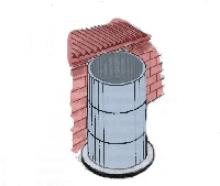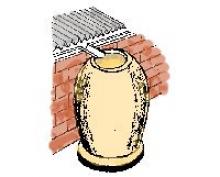Labour-saving technologies and practices: roof water harvesting
The following practice explains roof water systems, its features of roof water systems, (basic requirements and typologies, below ground storage systems, partial below ground systems, above ground storage, amount of water collected), as well as runoff collection and simple water filters. Advantages and disadvantages of these practices are also provided, which include labour saving, livelihood resilience strengthening, livelihood diversification, equipment, costs, and skills.
Description
Many different systems are used to collect and store rainwater, namely:
- below ground storage;
- hanging a plastic sheet across poles collecting water beneath through a hole in the centre;
- partial below ground;
- placing a plastic sheet on the ground collecting water beneath through a hole in the centre;
- above ground storage;
- placing containers underneath banana leaves, trees and roof eaves.
1. Features of roof water systems
1.1 Basic requirements
The basic requirements are:
- a roof (preferably rectangular);
- corrugated iron or tiled roof is preferable, but closely packed thatching also works (do not use asbestos as itis harmful to health);
- gutters;
- low cost guttering systems can be made from, for example, split bamboo;
- down pipe;
- concrete base; and
- storage system;
- ranging from earthenware jars to large tanks of 30 000 litres.
1.2 Below ground storage systems
Below ground storage is a cheap system to construct because of the support of the side walls, however water needs pumping up and this system is more difficult to clean.
1.3 Partial below ground systems
A circular hole is dug into the ground and lined with polyethylene or plaster. It is covered with a roof (from thatch or iron sheets) to protect the water from sunlight, birds and animals.
1.4 Above ground storage
A round tank is constructed from:
- curved galvanised sheets;
- ferro-cement; or
- bricks.
This system does not require a pump, cleaning is easier and leaks can be detected easily. A concrete base is desirable.
Storage systems should prevent:
- mosquitoes entering and breeding in the water; and
- sunlight that stimulates algae growth.
Easy access to all storage systems is necessary for periodic cleaning.
A first flush system can be incorporated to flush away the first rainwater, which has dislodged leaves and dirt after a long dry spell.
1.5 Amount of water collected
The amount of water collected depends upon various factors:
- dimensions of collecting surface;
- millimetres of rainfall; and
- storage capacity.
For example, a house with a 7 m x 7 m roof catches 500 litres of water from 10 mm of rainfall. In an area with an annual rainfall of 750 mm and 75 percent efficiency on a well designed and constructed system, yields 28 000 litres per year. If an average family consumes 100 litres per day then that is enough water for 280 days (assuming there is sufficient storage).
Rainwater is clean and can usually be used for drinking and domestic purposes without filtering, depending on the cleanliness of the roof and storage system.
2. Features of runoff collection
Runoff water may be collected:
- from impermeable surfaces such as granite or rocky outcrops (see figure 1 and 2);
- stored in a tank and possibly piped downhill to the community; and
- during heavy rains from any suitable land;
- lead and directed to uncontaminated pond or subsurface collection area.
Figure 1. Ferro-cement tank

©FAO/TECA
Figure 2. Reinforced mortar tank

©FAO/TECA
3. Features of simple water filters
Use of water filters is highly desirable to get clean drinking water.
Simple water filters can be made by:
- filling large containers with graded sands and charcoal; and
- providing an outlet at the base.
Water filters improve water purity and reduce water borne diseases.
4. Advantages
4.1 Labour saving
The practice saves time by delivering the source of water closer to home.
4.2 Livelihood resilience strengthening
Cleaner water improves the health of community members.
The increase of the volume of available water also:
- secures supply;
- eliminates the strain of looking for water sources during dry periods; and
- minimises surface runoff and soil erosion.
4.3 Livelihood diversification
If a large amount of runoff water is collected, it can also be used for irrigating vegetable gardens near the house.
The collected roof water can feed directly into a low cost drip irrigation system if the storage tank is located approximately 1.5 m above the area to be irrigated.
Opportunities for earning income can arise by constructing storage tanks.
5. Disadvantages
5.1 Equipment
Roofwater harvesting needs adequate and clean:
- roof area
- gutters
- storage tank.
5.2 Cost
Low cost storage systems are available but have limited storage capacity (around USD 100 for 1 500 litres).
5.3 Skills
Storage tank requires adequate training in terms of:
- construction
- maintenance
- use.
6. Related/associated technologies
- Water management in organic agriculture: ID 8366.
- Rooftop water collection, drip irrigation and plastic mulching in home garden conditions in drought prone areas: ID 8934.
- Soil and water conservation practices to reduce soil erosion and enhance water conservation: ID 7861.
- Rooftop rainwater harvesting: ID 7387.
- Roof top rainwater harvesting: concrete tank: ID 7513.
- Rainwater harvesting for increased pasture production: ID 7358.
7. Objectives fulfilled by the project
7.1 Labour-saving technology (LST)
The practice allows for time-saving provided that the water source is located closer to households.
7.2 Resource use efficiency
The practice partly eliminates the strain, during dry periods, to water source and prevents soil quality depletion. The water is also used more efficiently for irrigation.
7.3 Pro-poor technology
The practice allows for cleaner hence healthier water. Irrigation and water storage increase yields creating additional income.
